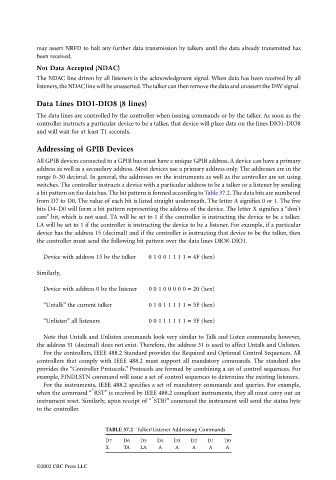Page 1066 - The Mechatronics Handbook
P. 1066
may assert NRFD to halt any further data transmission by talkers until the data already transmitted has
been received.
Not Data Accepted (NDAC)
The NDAC line driven by all listeners is the acknowledgment signal. When data has been received by all
listeners, the NDAC line will be unasserted. The talker can then remove the data and unassert the DAV signal.
Data Lines DIO1-DIO8 (8 lines)
The data lines are controlled by the controller when issuing commands or by the talker. As soon as the
controller instructs a particular device to be a talker, that device will place data on the lines DIO1-DIO8
and will wait for at least T1 seconds.
Addressing of GPIB Devices
All GPIB devices connected to a GPIB bus must have a unique GPIB address. A device can have a primary
address as well as a secondary address. Most devices use a primary address only. The addresses are in the
range 0–30 decimal. In general, the addresses on the instruments as well as the controller are set using
switches. The controller instructs a device with a particular address to be a talker or a listener by sending
a bit pattern on the data bus. The bit pattern is formed according to Table 37.2. The data bits are numbered
from D7 to D0. The value of each bit is listed straight underneath. The letter A signifies 0 or 1. The five
bits D4–D0 will form a bit pattern representing the address of the device. The letter X signifies a “don’t
care” bit, which is not used. TA will be set to 1 if the controller is instructing the device to be a talker.
LA will be set to 1 if the controller is instructing the device to be a listener. For example, if a particular
device has the address 15 (decimal) and if the controller is instructing that device to be the talker, then
the controller must send the following bit pattern over the data lines DIO8-DIO1.
Device with address 15 be the talker 0 1 0 0 1 1 1 1 = 4F (hex)
Similarly,
Device with address 0 be the listener 0 0 1 0 0 0 0 0 = 20 (hex)
“Untalk” the current talker 0 1 0 1 1 1 1 1 = 5F (hex)
“Unlisten” all listeners 0 0 1 1 1 1 1 1 = 3F (hex)
Note that Untalk and Unlisten commands look very similar to Talk and Listen commands; however,
the address 31 (decimal) does not exist. Therefore, the address 31 is used to affect Untalk and Unlisten.
For the controllers, IEEE 488.2 Standard provides the Required and Optional Control Sequences. All
controllers that comply with IEEE 488.2 must support all mandatory commands. The standard also
provides the “Controller Protocols.” Protocols are formed by combining a set of control sequences. For
example, FINDLSTN command will issue a set of control sequences to determine the existing listeners.
For the instruments, IEEE 488.2 specifies a set of mandatory commands and queries. For example,
*
when the command “ RST” is received by IEEE 488.2 compliant instruments, they all must carry out an
*
instrument reset. Similarly, upon receipt of “ STB?” command the instrument will send the status byte
to the controller.
TABLE 37.2 Talker/Listener Addressing Commands
D7 D6 D5 D4 D3 D2 D1 D0
X TA LA A A A A A
©2002 CRC Press LLC

